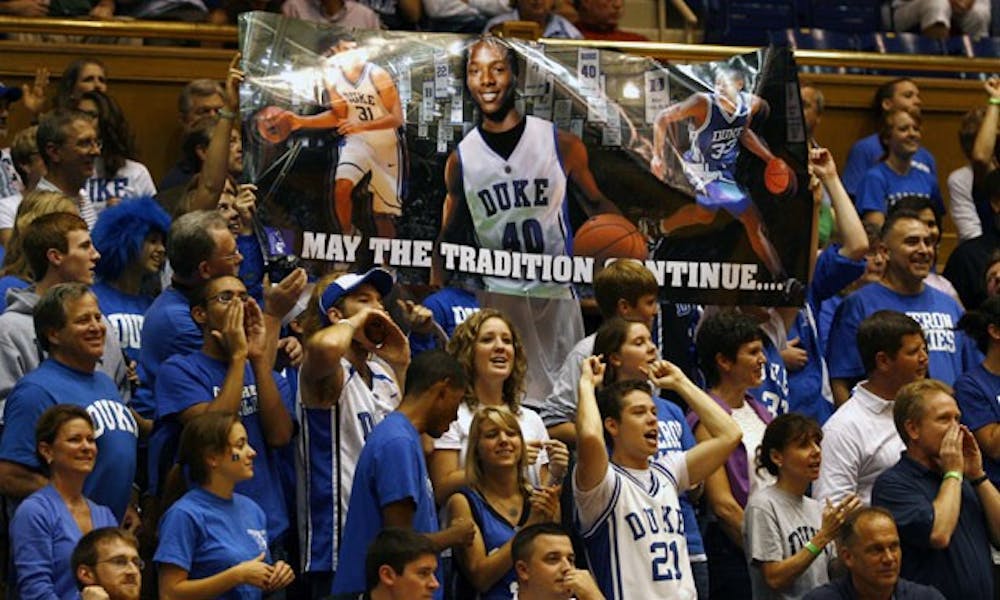The NCAA has many rules, and most of them, I’m sure, are logical. Like, boosters shouldn’t pay recruits to attend their alma maters, and coaches shouldn’t find geeks to take the SAT for a five-star prospect. These policies make sense, and I’m all for policies that make sense.
There are other compliance guidelines that don’t make that much sense. Did you know: outside of breakfast, lunch and dinner, teams can only give their players certain foods as snacks. Bagels are acceptable as carbohydrates, but cream cheese isn’t, and what’s a bagel without a schmear?
Ostensibly, the goal of the policy is to flatten recruiting advantages in college athletics—that is, certain schools can afford lox and cream cheese with chives, and others have to settle for tubes of Philly’s, and if a recruit likes lox, then the latter school doesn’t stand a chance. Of course, if a recruit likes Cameron Indoor Stadium, playing for the coach of Team USA and flying on chartered planes, then pretty much every school doesn’t stand a chance.
This is how a blanket rule with good intentions becomes nothing more than “the cream cheese rule.” Recruiting regulations work similarly, and Cameron was the setting for another dose of NCAA inanity this weekend.
Early Friday morning, hours after Kyrie Irving committed to Duke and before Harrison Barnes arrived for his official visit, a group of Duke students painted benches and hung signs out of windows with text like: “NCAA C_AMPS.” (There’s an H missing!) Technically, the signs could have been referring to, um, anyone, even though the target was pretty obvious. On Saturday, the line monitors distributed posters directed at the same recruit, and one even smuggled a life-size cutout of said recruit in a Duke uniform, which was promptly confiscated by Event One staffers. Students pulled a similar trick when Irving visited a few weeks back by hanging signs outside dorms. If Irving didn’t see them in person, he must have seen pictures on the Internet.
Technically, the institution cannot arrange any publicity for a recruit, whether he be a fencer or the top forward in the country. The prospective student is supposed to see campus as it would appear on an average day, Cindy Hartmann, associate athletic director for compliance, told me Monday. It doesn’t matter whether the prospect is named outright or whether the reference is veiled. Anything that draws attention to a recruit’s campus visit is taboo.
But before we go any further, let’s review the visits of Irving and Barnes. In both cases, the Cameron Crazies did their best to lure the prospect. In both cases, Duke’s compliance officers did their job by ceasing the activity. And in both cases, the recruits got the message.
Maybe it’s me—I’m not a public policy major—but something seems off about that. Right now, the bulky legislative process of the NCAA makes it impossible for the governing body to keep up with technology. The spirit of the rule is one thing, but enforcement is an entirely different matter. No one used the Internet when some of these rules were passed and now, as Hartmann pointed out, a recruit can take care of his own publicity by announcing his visit on Facebook or Twitter. Then what happens?
Can’t blame the students, even if they are breaking minor rules, because there are violations and then there are violations, and these types belong firmly in the former. Can’t blame compliance, either, for taking down signs when they became aware of them, because that’s what they’re paid to do.
So let’s lay the burden on the NCAA, whose recruiting regulations are still laughably lagging. (For comparison’s sake, this publicity rule was created in 1997 and last revised in 2003. Know what else happened in 2003? A faceless nobody moved into his sophomore dorm at Harvard. His name was Mark Zuckerberg.) It’s easy to remove a banner from campus. It’s damn near impossible to police a student who interacts with a recruit on Twitter.
And those hypotheticals don’t even delve into gray areas. What if I were to go to Cameron and hang a banner that read, “Harrison Barnes, Come To Duke!”, take it down immediately and then post the photo on every recruiting message board? What if I did it anonymously? Or what if I just Photoshopped that same sign into a snapshot of Cameron, then tweeted it directly at the recruit?
Let’s keep playing this game and move it to the realm of Facebook. Say I start a Facebook group about a certain prospect—I’m wondering whether any of these sentences would be acceptable by NCAA rules:
If your last name starts with “B” and ends with “arnes,” then some people at Duke think this fine university would suit you. No? If you’re a 6-foot-8 forward from Ames, Iowa, perhaps you should consider matriculating to the school you visited this weekend. Not there yet? If you’re Scout.com’s No. 1 player in the country, you might look good wearing No. 40 for a place of higher education in Durham, N.C. Still no?
OK, one more try. How about: If you play basketball, go to college. That sounds right.
Also, if there’s a Rolls Royce in your driveway, the NCAA kindly requests that you return it if you’re not going to use it. That thing was probably expensive.
Get The Chronicle straight to your inbox
Signup for our weekly newsletter. Cancel at any time.

